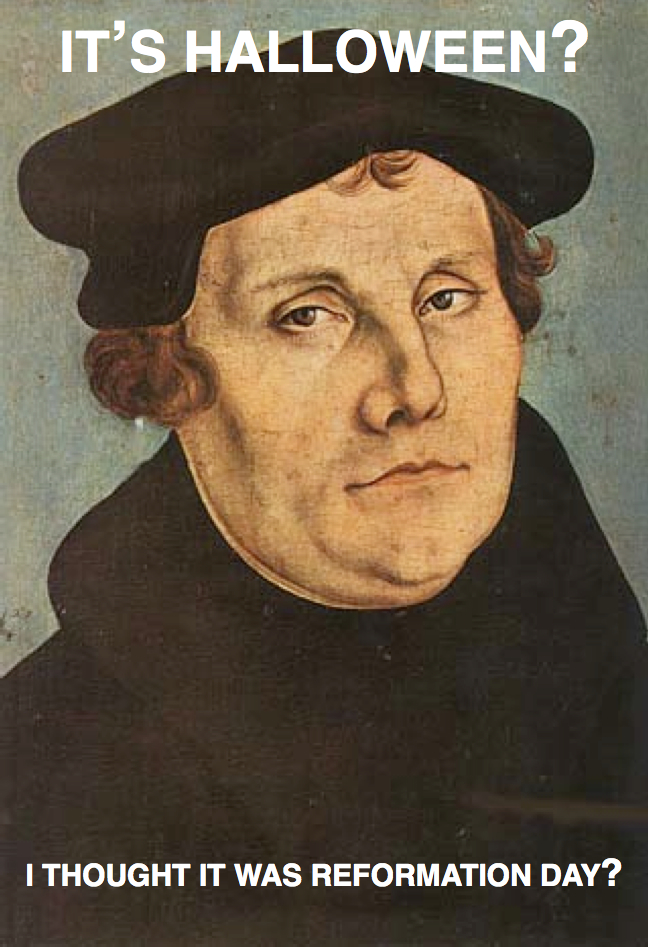Author: Craig H.
-

Going All Sorts of Gentile
It’s almost Pentecost, when the Holy Ghost went wild, which brings to fiery minds the thought of not only that particular world-turned-upside-down event but assorted others a whole lot like unto it, which other events alas never got their own red-letter day on the calendar, even though they probably deserved to, and so it occurred…
-

A Crazy Wild Reformation Day
For some reason, kids in my neighborhood don’t celebrate Halloween: they do Reformation Day instead. Right around 5, the little tikes start pounding on doors, dressed as characters of the Reformation and absolutely clamoring for people to tell them more about the big event.
-

Summertime Notes of a Liturgical Junkie
Four Services Worth Writing Home About. Mormon Service: An “International Ward” in Western Europe. (No, this picture to the left is not of a Mormon chapel, alas. It’s just an action shot to suggest what being a LJ might involve.) Up on the podium, the bishop is a Wasatch-Front-origined temporary-resident white Anglonavian Mormon, as is…
-
Bo Knows Heaven
So there’s my sort of neighbor big Bo, who despite owning two rock-solid Scandinavian names including, yes, Bo, doesn’t exactly seem to have things rock-solidly together.
-

Two Nuns Walk Into A Church
Almost 7, in the village church of Kernascléden, in the heart of Brittany, which is the heart of Catholicism in France. The sign on the door says Vespers are at 7, just like they are every night, even tonight, July 14, when most people in France are singing the Marseillaise instead of the Gloria. I…
-
How Things That Were Never Going to Change Have Sometimes Changed Anyway
In March at BYU I gave a talk, or more accurately for a guy who can barely use Power-Point, a multi-media extravaganza, involving at least 10 non-fancy slides with absolutely nothing moving around on them. The topic was the title above. For those who want to skip the movie and just read the book, I…
-
A Mission Epiphany For Epiphany Eve
Snow White. If on Christmas Day of 1975 you were for some harebrained reason outside on the frozen Belgian tundra and you squinted up your eyes against the shiny white landscape to look east from the edge of the little town called Zichem, then you would’ve almost certainly noticed in the houseless distance the improbable…
-
A Mission Dream For the Last Day of Autumn
Five-Sense Gray. 9:15 in the morning in the very late autumn in Belgium. It’s barely and unenthusiastically light because the sun has just come grudgingly up (if you call ten feet above the horizon up), and because the heavens are so blanketed with clouds that whatever slivers of rays manage to get through are absorbed right away…
-
Times and Seasons Welcomes Steve Smith
Times and Seasons is happy to welcome as a guest blogger Steve Smith, who teaches and writes mainly about religious freedom, constitutional law, and jurisprudence. His most recent book is The Disenchantment of Secular Discourse (Harvard University Press, 2010). Steve graduated from BYU in 1976 before studying law at Yale, and he has taught at…
-
Putting the Sunday in the Super Bowl
Some time ago on T&S, I survived a discussion on the history of Sunday (got no t-shirt though). That knock-down drag-out event included some talk of sports, but overall was pretty general. In light of the upcoming Super Bowl I thought it might be fun(?) to look at the rise of Sunday sport more specifically.…
-
Creativity as a Religious Virtue
I usually place empathy at the top of my ladder of desirable religious virtues because I see its presence as the cause of most good and its absence as the cause of most bad. But the more I’ve thought about it, the more it seems that even empathy depends on yet another important quality: creativity.
-
Hey, Are Those Real Miracles?
It happens every year. I’m walking past the library, or some other building loaded with windows, and one of my students bursts out the door and runs toward me with eyes dilating, hair frazzling, nerves fraying, arms waving, and body quaking to ask, out of breath, did these things really happen? “Things” referring to the…
-
Your Easter Sermon: Food Storage
Every year on T&S there appears around Easter time a certain amount of Holy-Week envy. I haven’t seen any yet this year, and so I thought I’d take my turn to express a little. Or better, maybe this would be a good opportunity to get a sense of what is going on in Mormon Easter…
-
Hugs and Kisses
It’s holiday season, which means more friends and family and greetings, in person or otherwise, than usual. Add to that a few weddings receptions and you can get downright sore from all the hugging and hand-wrenching. Not to mention confused by the vast array of possibilities for saying hello or goodbye or Merry Christmas or…
-
Teaching the Reformation
Just as I went to publish this post, I saw Ben’s post about the conference on Mormons and Evangelicals. It’s a nice coincidence. As are the recent posts by Kent and Marc on labeling and categorizing. I was already scheduled to attend another conference this week, an annual conference for historians of the Reformation (surely…
-
When Being Right is Wrong
If you’re a teacher of any sort, you know how disruptive a couple of talkative or rude students can be, especially when you’re trying to get a discussion going. In an effort to regain control, you flash a forced smile in the direction of the goof-offs. You pause and wait until they’re finished before you…
-
Carl and Mathilda
Let us praise pioneers. Of all sorts, but today especially the traditional sort. I myself am thinking of Carl and Mathilda, whom I came to know through one of those wholly unexpected spine-tingling unbelievable fantastic experiences.
-
What’s Your Master Status?
No, it’s not the same as Master Race, so banish that association from your head. Instead it’s a useful sociological concept (who knew?) which not only has come in handy for writing my current book, but goes a long way toward explaining why we get along, or not, with liberals, reactionaries, gays, homophobes, gun-nuts, gun-controllers,…
-
Quorum Fun
A few months ago this was the calendar, word for word, sent out to a nearby quorum in a sleepy suburban ward (hint: it’s in the US). March 15th: Concealed Weapons Class, 1pm at the [deleted] home. Joint activity with the High Priests. Punch and cookies served. (Okay I added the punch and cookies bit.)
-
Girls’ Rules
My older sister was a great athlete in the old days (before Title IX), and just retired as the athletic director at a high school. Talking with her the other day gave me the idea for this post, so blame her if you don’t like it (isn’t that just like a little brother?). I thought…
-
How Sacred is Conscience?
Any guest or new blogger obviously runs the risk of repeating topics that have been worn into the ground. Apologies in advance if that is the case here, but it seemed to me that possibly missing in the current debate, er, discussion, over a certain issue in California and how church members ought to respond…
